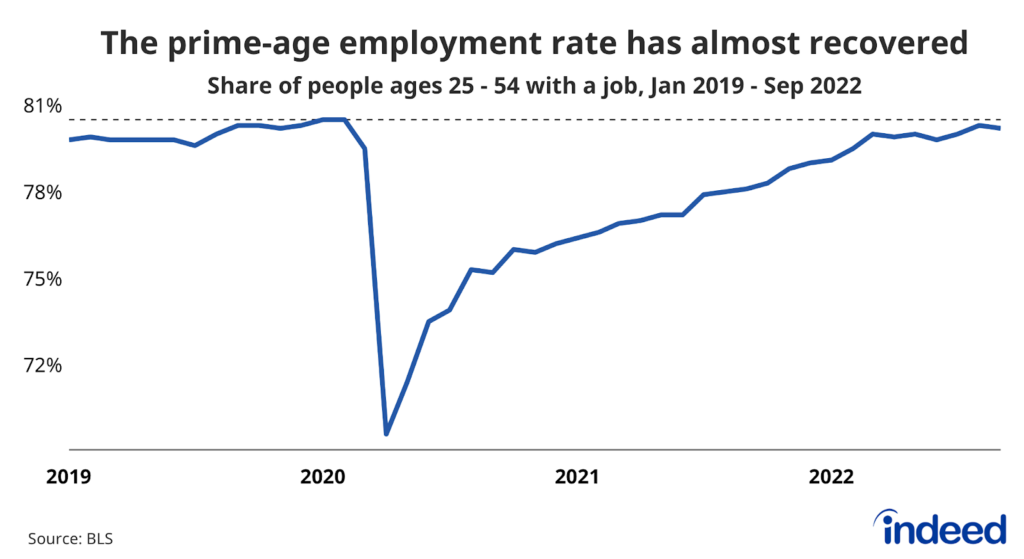Key Points:
- In August 2022, 4% of total clicks on Indeed US job postings were from job seekers located abroad, up 57% from the pre-pandemic high of 2.5%.
- Foreign interest has shifted toward Asia and away from Canada and Europe, with India the largest source of foreign clicks through the first eight months of 2022.
- Interest in US jobs from Pakistan surged in 2022, driven largely by political tensions and natural disasters.
- From 2019 to 2022, foreign click share grew fastest in remote-friendly sectors such as Software Development, Information Design & Documentation, and Media & Communications.
The COVID-19 pandemic has had a significant impact on the US labor supply — especially the foreign talent pool. Restrictions in international travel dramatically slowed immigration in 2020 and 2021. This slowing led to an estimated two million fewer working-age immigrants than there would have been had pre-pandemic immigration trends continued.
This drop in immigration has a particular impact in a country like the United States, where foreign talent makes up a significant portion of the labor market. In August 2022, foreign-born workers accounted for 21.4% of all US prime-age employment, that is, of workers between 25 and 54. Additionally, the loss of potential working-age immigrants for the past several years may have led to more unfilled positions in an already-tight US labor market.
We will never know what immigration levels would have been had the pandemic not occurred. However, Indeed’s global search data show how foreign job seekers interacted with US job postings during the pandemic, providing a gauge of international interest in working in this country.
Overall, foreign interest in US job postings has risen from pre-pandemic levels, driven in part by increases from Asia. Remote-friendly occupations like Software Development, Marketing, and Media & Communications have experienced rapidly rising interest. In contrast, in-person positions such as Retail, Veterinary, and Dental have recorded slower growth in traffic from abroad.
Foreign interest declined before the pandemic but has accelerated since
Before the pandemic, the foreign share of total clicks on US job postings on Indeed peaked around 2.5% before falling in 2019. A key driver of that drop was high domestic job seeker activity, which diluted the share of foreign clicks. However, since the beginning of the pandemic in 2020, the share of foreign interest in US job postings has not only returned to pre-pandemic averages, but accelerated despite COVID-related travel restrictions and barriers to immigration.
When the pandemic hit in spring 2020, the foreign share of clicks on US job ads jumped as international job seekers remained active relative to their domestic counterparts. This might be explained by the types of jobs foreigners click on. In general, international traffic tends to skew toward jobs in remote-friendly sectors like Software Development and Marketing. Presumably for that reason, foreign job seekers stayed active as the pandemic hit, while domestic job seekers — especially those in fields typically requiring in-person employment — hesitated to look for work.
The sharp early pandemic spike in foreign share ended quickly, but an overall shift continued in 2021 and 2022 as international interest trended upward. In August 2022, the foreign share of total clicks hit 4% — a 57% increase from the pre-pandemic high.
Overall, the increase in foreign click share has persisted since early 2020 despite travel restrictions and other barriers to immigration.
Geographic composition of foreign interest has shifted toward Asia and away from Canada and Europe
One of the most significant drivers of the sustained increase in foreign interest has been a rise in the share of clicks from Asia. In August 2019, Asia accounted for 37.2% of foreign clicks on US jobs. Fast forward three years to August 2022 and that share had grown to 47.1%. In other words, nearly half of foreign interactions with US job postings on Indeed came from job seekers in Asia.
Over the same three-year period, Europe — the second largest source of foreign interest — fell from 25% of foreign clicks to 18.1%. International interest also shifted from North America, which declined from 16.3% to 14.8%.
These changes in geographic composition are more apparent when foreign interest is broken down by country. A year-to-date comparison between 2022 and 2019 finds three of the top five largest increases in foreign click share came from Asia.
Pakistan experienced the most significant increase, 2.7 percentage points, and grew to an average of 4% of all foreign clicks in 2022. Declines in foreign click shares from Canada, Australia, and Europe partially offset the significant increases from Asia. A key driver behind this geographic shift is Asia’s enormous population. Since that continent is home to nearly 60% of the world’s people, it is not surprising it would have a large click share.
India remains largest source of foreign interest, edging out Europe and Germany
In August 2019, India led all countries, with a foreign click share of 17.6%. Two European countries, the UK and Germany, were among the pack behind India. Over the next three years, India’s share grew gradually to 19.4%. Meanwhile, those leading European countries were edged out by stronger interest from Japan and Pakistan. As a result, four of the top six sources of foreign traffic on Indeed in August 2022 were Asian countries, while the UK and Germany dropped out of the top six.
Environmental and economic conditions are influencing Pakistani job seeker interest
Part of this year’s jump in interest from Asia can be attributed to Pakistan. At the beginning of 2022, the South Asian country accounted for 1.9% of the clicks on US job postings on Indeed. Political tensions and the removal of Prime Minister Imran Khan led to a surge in foreign click share, which reached 4.2% on April 9 — the day of Khan’s removal.
In June, record monsoon rainfall caused massive flooding in Pakistan. This put great economic pressure on the country, with inflation reaching 21.3% and 24.9% in June and July respectively. The floods touched off another spike in Pakistan’s click share, which peaked at 6.2% on June 29. Since then, interest from Pakistan has pulled back. This may signal a shift in the trend, but the decline also could stem from damaged infrastructure and loss of internet access, which could have prevented job seekers from using Indeed.
The share of foreign clicks growing strongest in remote-friendly occupations
Examining foreign interest by occupational group shows which opportunities international job seekers are interested in. From 2019 to 2022, eight of the 10 biggest gains in foreign share occurred in sectors with high levels of remote work — including Software Development, Marketing, and Media & Communications. Additionally, many of these positions are STEM-related (science, technology, engineering, and mathematics) and meet the education and specialization requirements for the H1-B visa program. The most significant increase occurred in Software Development, where foreign share grew 7.6 percentage points, now accounting for 20.5% of worldwide clicks on US job postings.
While these areas saw the largest increases, there were some sectors where the foreign share of interest grew quickly from low levels. For instance, foreign clicks on Driving jobs grew from a 0.7% share in 2019 to 2.7% three years later — a 268% increase. Nursing surged 243% over the same period, with its share increasing from 0.9% to 3.1%. While the overall footprint of these sectors remains small, strong growth rates suggest a shift toward foreigners seeking jobs in fields where employers are facing hiring difficulties, like Nursing. Overall, no occupational sector registered a fall in foreign interest between 2019 and 2022.
Conclusion
Several factors appear to influence foreign interest in US jobs, including the availability of remote work, a country’s relative population, and its political and economic conditions. Foreign interest in US jobs held up during the pandemic despite limitations on travel and immigration — and that’s welcome news for employers in a tight US labor market.
Methodology
We assess foreign job seeker interest in the US by tracking the share of total clicks on Indeed job postings in the US by job seekers with IP addresses outside of the US. Job seekers whose location could not be determined were removed from the analysis. All data in the post reflect seasonally adjusted, weighted 28-day moving averages. Data is imputed for Germany between July and November 2020 and for Honduras between June and July 2019.



